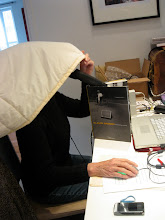You really can't go much more than one block in Paris without passing a "boulangerie" (bakery). We have four on our "foodie" rue Montorgeuil: Eric Kayser up at our end; a block away, an independent one, Boulangerie Blouet; one block further there's a Paul Bakery, and two doors down from that the Boulangerie Monge. Plus the three supermarkets carry bread, as do some of the specialty shops. No shortage of bread, although they don't all bake on the premises. And mostly, the biggest seller and front and centre in all the displays, is "la baguette".
Our tour guide, Marion, started us off in the front of the shop, where the breads line the back wall whilst the main counter displays a mouth-watering array of pastries, tarts, cakes, quiches, sandwiches and salads, all made on the premises. She walked us along the display, explaining what they all were...
...from these flaky, delicious individual quiches...
...to these delectable little fruit tarts...
...past this amazing column of eclairs, which now come in all kinds of flavors and icings...
...and she explained the origin of these round pastries here that look like bagels, but which are a choux pastry filled with praline flavored cream, topped with almonds. They are called "Paris-Brest-Paris" pastries and are the symbol of the Paris to Brest to Paris bicycle race that first took place in 1891 -- the pastries made their arrival in 1910, and their shape represents the bicycle wheel. They became a popular energy booster for the riders (major calorie content!). Nowadays, they can be bought in most patisseries, whether you are a cyclist, or not!
Squeezing ourselves past all these tempting goodies, we went behind the counter, through to the back of the bakery and began to learn how this operation works. Starting with the baguettes and these bowls of soft, almost cream-colored flour, stacked on racks, waiting to be transformed.
A small beater was busy at work mixing flour, water and yeast. This particular bakery makes its own yeast from flower blossoms.
And next to it, a large "kneader" had just finished its work, delivering a mound of dough that was set aside to rise, to do its magic!
When it comes out of the warming spot, the dough is flattened under that big round press you see in the background, then cut in squares, then roughly rolled into little sausage shapes and placed in a floured linen-lined trough. One at a time, they are picked out and hand-rolled into a baguette shape...
...tucked into racks of floured linen folds, and set aside one more time.
One by one, the racks come over to the head baker, Thierry, who makes five swift cuts across each piece of dough.
It's just an old-fashioned razor blade, attached to a stick! Thierry arrives at work five days out of seven at 3:00 am and works until 1:00 pm. He trained for six years -- two to be a baker, two more to be a pastry chef, and two more to be a master baker.
With a quick push from Thierry, the breads slip off their tray and into the oven, "whoosh", just like that!
Whilst that batch bakes, Thierry explains how to tell when the baguette is perfectly cooked: the underneath needs to have these darker blotches running down the length. That tells him that the crust has the right amount of "crunch", and the inside the right amount of airy space!
He's happy and proud to show us a batch of perfectly cooked baguettes, ready for the front of the shop!
He also told us that those four are but a tiny fraction of the 1000 baguettes they bake every day!!
(By now, some of us are getting seriously hungry...)
But Marion was not finished with her tour. We followed her downstairs, where we found Celeste, who is preparing the dough for croissants. That's a giant slab of frozen, sweet butter she is pounding with a rolling pin. A batch of dough waits on the side.
Now, the pounded butter is placed on the rolled-out dough...
...the dough is folded, corner by corner, over the butter, and the whole package is run through a heavy roller machine, then hand-rolled out and re-folded two times more. At this point, the dough is put in the freezer until it's time to bake the croissants. This bakery prepares enough dough for two to three days at a time...
...allowing them to have fresh croissants on hand at all times...
...or pain au chocolat, made from the same dough.
Back up in the shop, the list and prices of breads are updated regularly. The baguettes are first in line.
The bakery owner kindly gave each of us one of his "Baguette La Tradi du Patron" and a pain au chocolat...
...so with a final glance at the astonishing cakes that this small bakery had produced down "below stairs", I headed for home...
...where Matthew and I had a delicious lunch of our fresh baguette with traditional slices of baked ham and Emmental cheese.
And Matthew's pain au chocolat awaits as a late afternoon treat!
À bientôt!
Follow @JanetRobbins14




























































